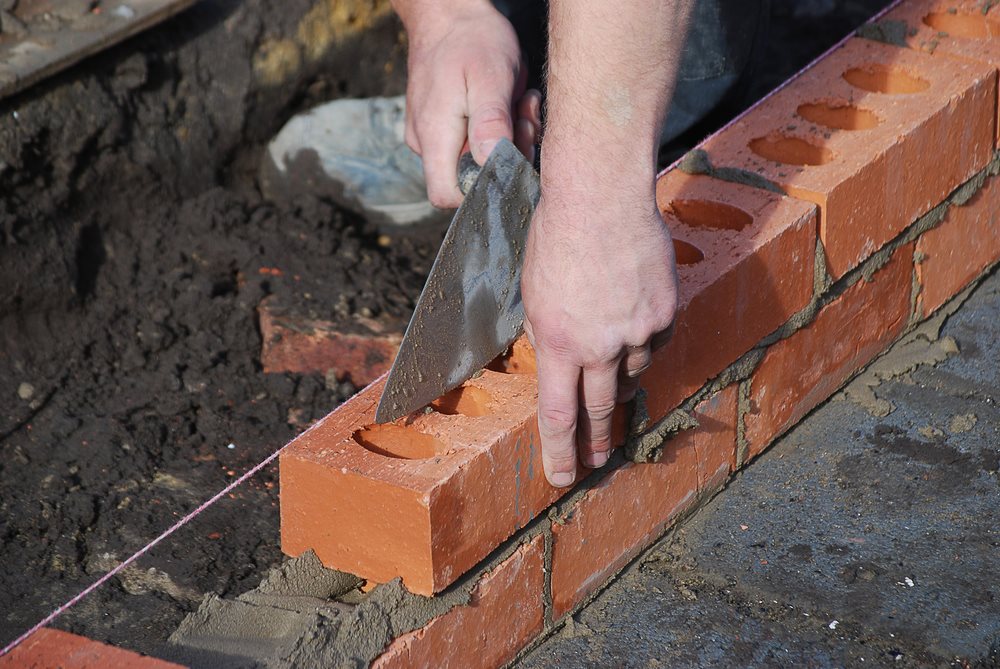Bricklayer Auckland - An Overview
Wiki Article
Not known Details About Bricklayer Auckland
Table of ContentsSome Known Factual Statements About Bricklayer Auckland The Best Strategy To Use For Bricklayer AucklandNot known Factual Statements About Bricklayer Auckland The Main Principles Of Bricklayer Auckland
The distinction between no and also traditional stonework is in the laying of the block. The block is no more pushed vertically, however tilted. ZERO has an unique opening on the top side of the block. Therefore the mortar bed is reduced. It will certainly sink also deeper when the next program of bricks is laid.On top of that, we likewise focused on an excellent proportion between the length as well as size of the block to make sure that it is ideal for dealing with a stretcher bond. This method the job continues quickly. Advantage, For a specialist in this manner of functioning is rarely an obstacle. He can deal with the material/equipment that is acquainted to him.
Bricklayers are a vital profession in the construction market, in charge of laying blocks, pre-cut rock as well as cinder block in mortar. Bricklayers construct, prolong as well as repair residential and commercial buildings, and also various other frameworks such as foundations, walls, chimneys or attractive stonework. Getting to the end of a project and also having the ability to claim 'I developed that' uses a genuine sense of achievement for brickies.
Your time as a bricklaying apprentice will typically be divided between your company and training provider (such as an university), with at least 20% of your typical functioning hours invested in training. Your training might take place every week, on a monthly basis or in a separate block of time, and also it can take place at your workplace, at your training copyright or online.
Everything about Bricklayer Auckland
When investigating construction, you inevitably find that any kind of brand-new or innovative concept has in fact been attempted over and also over again, usually stretching back decades. One of these new-but-actually-old concepts is the suggestion of a mechanical bricklayer, a device to automate the building of masonry walls. It's easy to see the charm of this suggestion - masonry building and construction appears nearly flawlessly fit for mechanization.It does not feel like it would certainly call for literally complicated motions - each brick gets a layer of mortar used, and also is simply stocked location alongside the previous one. And also due to the fact that each physical joint coincides size, placement is almost deterministic - each block coincides set distance from the previous one.
These machines could not notice anything regarding their environment, or action where a brick needed to go - they merely extruded a layer of mortar and mechanically positioned a brick at regular periods (Bricklayer Auckland). It's unclear the amount of of these devices ever before made it beyond the attracting board, however at the very least among find out this here these (John Knight's) was used to construct a brick wall surface that presumably still stands today.
Over the years, stonework has decreased in value as a construction technology in the industrialized globe, as well as with it the passion in automating it. Unlike with concrete 3D printing, where there are lots of efforts to develop the innovation, I can just discover a handful of current efforts to automate stonework. Bricklayer Auckland.
Not known Details About Bricklayer Auckland
It can placing blocks in limited corridors or complicated corners, and Hadrian can create all the wall surfaces of a small building with simply a couple of actions of the automobile. Hadrian can presently set around 200 blocks a hr, yet they're intending to be able to do 1000 obstructs an hour or more (the blocks it sets are different from the block masonry used in the United States, but in United States masons can establish somewhere in the area of 400 blocks a day).
SAM has a collection of sensing units to compensate for the activity of the platform check my blog and guarantee it's placing blocks level, and also can deal with blocks of all various sizes (though it will not build CMU obstruct walls). It gets placed to a movable scaffolding that's increased gradually as the wall surface is completed.
The promotional material on Building and construction Robotics' website suggests that it's no longer their primary emphasis - even more emphasis is provided to their various other item, MULE.Other than SAM as well as Hadrian, there are a couple of various other mechanical bricklayers in various phases of development. You additionally see the periodic academic initiative. One area where we do see some business success with mechanical bricklaying is with block roads - a variety of business use devices that can "publish" an area of road made of blocks.
Bricklayer Auckland for Dummies
A slightly various group of makers aimed at improving stonework performance is what I'll call "stonework assistants". These are machines made to help with physically lifting the block (they appear to be a lot more usual with block than brick) and taking the pressure off the mason, while still permitting the mason to control it right into placement, Stonework assistants day from at least 1994, when the military experimented with MOTHER, the Mechatronically Assisted Mason's Aid.
Report this wiki page